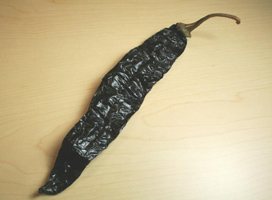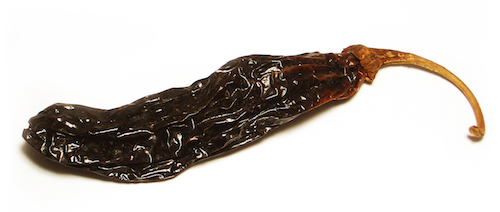By Dave DeWitt
Fiery Foods & BBQ Central Recommendations
Chile Pepper Bedding Plants… over 500 varieties from Cross Country Nurseries, shipping April to early June. Fresh pods ship September and early October. Go here
Chile Pepper Seeds… from all over the world from the Chile Pepper Institute. Go here
Photos by Harald Zoschke
The Plant
In Spanish, pasilla means “little raisin,” an allusion to the dark brown pods and their raisiny aroma. In California the ancho is sometimes called pasilla, causing much confusion. In western Mexico it is sometimes called chile negro, a term that also refers to the darker anchos. In the fresh form, the pod is known as chilaca.
 Pasillas are pod types of the annuum species. The plant has an intermediate number of stems, an erect habit, and grows 2 to 3 feet high or more. The primary branches begin over 5 inches from the lowest stem portion so the pods will not touch the ground. The leaves are ovate, smooth, medium green in color, and measure 3 inches long and 1 ½ inches wide. The flowers have white corollas with no spots. The pods are extremely elongate, cylindrical, furrowed, and measure 6 inches long (or more) by 1 inch wide. Immature fruits are dark green, maturing to dark brown. The growing period is 90 to 100 days, and the yield is 20 pods or more to the plant. This type is not particularly pungent; measuring between 1,000 and 1,500 Scoville Units.
Pasillas are pod types of the annuum species. The plant has an intermediate number of stems, an erect habit, and grows 2 to 3 feet high or more. The primary branches begin over 5 inches from the lowest stem portion so the pods will not touch the ground. The leaves are ovate, smooth, medium green in color, and measure 3 inches long and 1 ½ inches wide. The flowers have white corollas with no spots. The pods are extremely elongate, cylindrical, furrowed, and measure 6 inches long (or more) by 1 inch wide. Immature fruits are dark green, maturing to dark brown. The growing period is 90 to 100 days, and the yield is 20 pods or more to the plant. This type is not particularly pungent; measuring between 1,000 and 1,500 Scoville Units.
Agriculture

Pasilla: Dry
It is likely that the pasilla is the immediate predecessor of the New Mexican type, and it has adapted particularly well to the temperate regions of Mexico. About 7,500 acres of pasillas are cultivated in Mexico, primarily in Aguascalientes, Jalisco, Zacatecas, and Guanajuato, with the annual yield amounting to approximately 3,500 tons of dried pods. The most popular Mexican varieties are ‘Pabellon One’ and ‘Apaseo.’ There is no commercial U.S. production, but the pasilla does well in the home garden, and the pods should be allowed to dry on the plant.
Culinary Usage
The pasilla is part of the legend of the origin of mole sauces, which also contain anchos. Because it is very flavorful, the pasilla is a favorite of Mexican moleros, cooks who specialize in preparing unique mole sauces. The pasilla is mainly used in the dried pod or powder form in sauces such as moles and adobos. It adds an interesting taste and color to standard red chile enchilada sauce as well.





